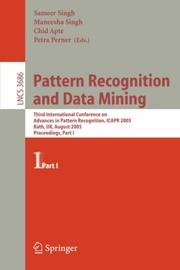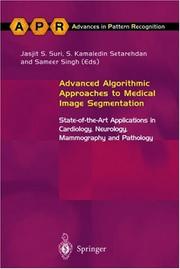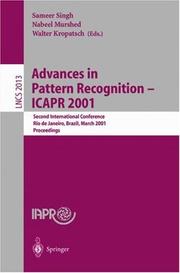| Listing 1 - 9 of 9 |
Sort by
|

ISBN: 9783540287575 3540287574 9783540288336 3540288333 3540319999 3540287582 Year: 2005 Publisher: Berlin : Springer,
Abstract | Keywords | Export | Availability | Bookmark
 Loading...
Loading...Choose an application
- Reference Manager
- EndNote
- RefWorks (Direct export to RefWorks)
Pattern recognition. --- Optical data processing. --- Information storage and retrieval. --- Application software. --- Database management. --- Artificial intelligence. --- Pattern Recognition. --- Image Processing and Computer Vision. --- Information Storage and Retrieval. --- Information Systems Applications (incl. Internet). --- Database Management. --- Artificial Intelligence. --- Application computer programs --- Application computer software --- Applications software --- Apps (Computer software) --- Computer software --- Optical computing --- Visual data processing --- Bionics --- Electronic data processing --- Integrated optics --- Photonics --- Computers --- Design perception --- Pattern recognition --- Form perception --- Perception --- Figure-ground perception --- AI (Artificial intelligence) --- Artificial thinking --- Electronic brains --- Intellectronics --- Intelligence, Artificial --- Intelligent machines --- Machine intelligence --- Thinking, Artificial --- Cognitive science --- Digital computer simulation --- Logic machines --- Machine theory --- Self-organizing systems --- Simulation methods --- Fifth generation computers --- Neural computers --- Data base management --- Data services (Database management) --- Database management services --- DBMS (Computer science) --- Generalized data management systems --- Services, Database management --- Systems, Database management --- Systems, Generalized database management --- Optical equipment --- Data mining. --- Data Mining and Knowledge Discovery. --- Algorithmic knowledge discovery --- Factual data analysis --- KDD (Information retrieval) --- Knowledge discovery in data --- Knowledge discovery in databases --- Mining, Data --- Database searching --- Pattern recognition systems --- Data mining
Multi
ISBN: 9783540319993 Year: 2005 Publisher: Berlin Heidelberg Springer-Verlag GmbH
Abstract | Keywords | Export | Availability | Bookmark
 Loading...
Loading...Choose an application
- Reference Manager
- EndNote
- RefWorks (Direct export to RefWorks)
This LNCS volume contains the papers presented at the 3rd International C- ferenceonAdvances in PatternRecognition(ICAPR2005)organizedin August, 2005 in the beautiful city of Bath, UK. The conference was ?rst organized in November 1998 in Plymouth, UK and subsequently in March 2001 in Rio de Janeiro, Brazil. The conference encouraged papers that made signi?cant th- reticalandapplication-basedcontributions inpatternrecognition. The emphasis was on an open exchange of ideas and shared learning. The papers submitted to ICAPR 2005 were thoroughly reviewed by up to three referees per paper and less than 40% of the submitted papers were accepted. The papers have been ?nally published as two volumes of LNCS and these are organized under the themes of Pattern Recognition and Data Mining (which included papers from the trackson PatternRecognition Methods, Knowledgeand Learning,and Data Mining), and Pattern Recognition and Image Analysis (which included papers from the Applications track). From the conference technical programme point of view, the ?rst volume contains papers on pattern recognition, data mining, signal processing and OCR/document analysis. The second volume contains - pers from the Workshop on Pattern Recognition for Crime Prevention, Security and Surveillance, Biometrics, Image Processing and Medical Imaging. ICAPR 2005was run in parallel with the InternationalWorkshop on Pattern Recognition for Crime Prevention, Security and Surveillance that was organized onthe22ndofAugust,2005. Thisworkshopbroughttogethera number ofexc- lent papers that focussed on how pattern recognition techniques can be used to developsystemsthathelpwithcrimepreventionanddetection. Onthesameday, a number of tutorials were also organized.
Mathematical statistics --- Information systems --- Artificial intelligence. Robotics. Simulation. Graphics --- Computer. Automation --- patroonherkenning --- beeldverwerking --- beeldanalyse --- ICT (informatie- en communicatietechnieken) --- IR (information retrieval) --- factoranalyse --- informatiesystemen --- database management --- robots
Book
Year: 2005 Publisher: Berlin : Springer,
Abstract | Keywords | Export | Availability | Bookmark
 Loading...
Loading...Choose an application
- Reference Manager
- EndNote
- RefWorks (Direct export to RefWorks)
Pattern recognition. --- Optical data processing. --- Information storage and retrieval. --- Application software. --- Database management. --- Artificial intelligence. --- Pattern Recognition. --- Image Processing and Computer Vision. --- Information Storage and Retrieval. --- Information Systems Applications (incl. Internet). --- Database Management. --- Artificial Intelligence. --- Pattern recognition systems
Book
Year: 2005 Publisher: Berlin : Springer,
Abstract | Keywords | Export | Availability | Bookmark
 Loading...
Loading...Choose an application
- Reference Manager
- EndNote
- RefWorks (Direct export to RefWorks)
Pattern recognition. --- Optical data processing. --- Information storage and retrieval. --- Application software. --- Database management. --- Artificial intelligence. --- Pattern Recognition. --- Image Processing and Computer Vision. --- Information Storage and Retrieval. --- Information Systems Applications (incl. Internet). --- Database Management. --- Artificial Intelligence. --- Pattern recognition systems
Book
Year: 2005 Publisher: Berlin : Springer,
Abstract | Keywords | Export | Availability | Bookmark
 Loading...
Loading...Choose an application
- Reference Manager
- EndNote
- RefWorks (Direct export to RefWorks)
Pattern recognition. --- Optical data processing. --- Information storage and retrieval. --- Application software. --- Database management. --- Artificial intelligence. --- Pattern Recognition. --- Image Processing and Computer Vision. --- Information Storage and Retrieval. --- Information Systems Applications (incl. Internet). --- Database Management. --- Artificial Intelligence. --- Pattern recognition systems

ISBN: 1852333898 Year: 2002 Publisher: London : Springer,
Abstract | Keywords | Export | Availability | Bookmark
 Loading...
Loading...Choose an application
- Reference Manager
- EndNote
- RefWorks (Direct export to RefWorks)
Diagnostic imaging --- Pattern perception. --- Perception des structures. --- Imagerie pour le diagnostic --- Digital techniques. --- Techniques numériques.

ISBN: 3540417672 3540447326 Year: 2001 Publisher: Berlin, Heidelberg : Springer Berlin Heidelberg : Imprint: Springer,
Abstract | Keywords | Export | Availability | Bookmark
 Loading...
Loading...Choose an application
- Reference Manager
- EndNote
- RefWorks (Direct export to RefWorks)
The paper is organized as follows: In section 2, we describe the no- orientation-discontinuity interfering model based on a Gaussian stochastic model in analyzing the properties of the interfering strokes. In section 3, we describe the improved canny edge detector with an ed- orientation constraint to detect the edges and recover the weak ones of the foreground words and characters; In section 4, we illustrate, discuss and evaluate the experimental results of the proposed method, demonstrating that our algorithm significantly improves the segmentation quality; Section 5 concludes this paper. 2. The norm-orientation-discontinuity interfering stroke model Figure 2 shows three typical samples of original image segments from the original documents and their magnitude of the detected edges respectively. The magnitude of the gradient is converted into the gray level value. The darker the edge is, the larger is the gradient magnitude. It is obvious that the topmost strong edges correspond to foreground edges. It should be noted that, while usually, the foreground writing appears darker than the background image, as shown in sample image Figure 2(a), there are cases where the foreground and background have similar intensities as shown in Figure 2(b), or worst still, the background is more prominent than the foreground as in Figure 2(c). So using only the intensity value is not enough to differentiate the foreground from the background. (a) (b) (c) (d) (e) (f).
Pattern recognition systems --- Electrical Engineering --- Electrical & Computer Engineering --- Engineering & Applied Sciences --- Singh, Sameer --- editor. --- Computer science. --- Text processing (Computer science). --- Computer graphics. --- Image processing. --- Pattern recognition. --- Computer Science. --- Pattern Recognition. --- Image Processing and Computer Vision. --- Computer Graphics. --- Document Preparation and Text Processing. --- Optical pattern recognition. --- Computer vision. --- Natural language processing (Computer science). --- Natural Language Processing (NLP). --- NLP (Computer science) --- Artificial intelligence --- Electronic data processing --- Human-computer interaction --- Semantic computing --- Automatic drafting --- Graphic data processing --- Graphics, Computer --- Computer art --- Graphic arts --- Engineering graphics --- Image processing --- Machine vision --- Vision, Computer --- Optical data processing --- Pattern perception --- Perceptrons --- Visual discrimination --- Digital techniques --- Optical data processing. --- Optical computing --- Visual data processing --- Bionics --- Integrated optics --- Photonics --- Computers --- Design perception --- Pattern recognition --- Form perception --- Perception --- Figure-ground perception --- Optical equipment --- Pattern perception. --- Natural language processing (Computer science)
Book
ISBN: 9783540287582 Year: 2005 Publisher: Berlin Heidelberg Springer Berlin Heidelberg
Abstract | Keywords | Export | Availability | Bookmark
 Loading...
Loading...Choose an application
- Reference Manager
- EndNote
- RefWorks (Direct export to RefWorks)
This LNCS volume contains the papers presented at the 3rd International C- ferenceonAdvances in PatternRecognition(ICAPR2005)organizedin August, 2005 in the beautiful city of Bath, UK. The conference was ?rst organized in November 1998 in Plymouth, UK and subsequently in March 2001 in Rio de Janeiro, Brazil. The conference encouraged papers that made signi?cant th- reticalandapplication-basedcontributions inpatternrecognition. The emphasis was on an open exchange of ideas and shared learning. The papers submitted to ICAPR 2005 were thoroughly reviewed by up to three referees per paper and less than 40% of the submitted papers were accepted. The papers have been ?nally published as two volumes of LNCS and these are organized under the themes of Pattern Recognition and Data Mining (which included papers from the trackson PatternRecognition Methods, Knowledgeand Learning,and Data Mining), and Pattern Recognition and Image Analysis (which included papers from the Applications track). From the conference technical programme point of view, the ?rst volume contains papers on pattern recognition, data mining, signal processing and OCR/document analysis. The second volume contains - pers from the Workshop on Pattern Recognition for Crime Prevention, Security and Surveillance, Biometrics, Image Processing and Medical Imaging. ICAPR 2005was run in parallel with the InternationalWorkshop on Pattern Recognition for Crime Prevention, Security and Surveillance that was organized onthe22ndofAugust,2005. Thisworkshopbroughttogethera number ofexc- lent papers that focussed on how pattern recognition techniques can be used to developsystemsthathelpwithcrimepreventionanddetection. Onthesameday, a number of tutorials were also organized.
Mathematical statistics --- Information systems --- Artificial intelligence. Robotics. Simulation. Graphics --- Computer. Automation --- patroonherkenning --- beeldverwerking --- ICT (informatie- en communicatietechnieken) --- IR (information retrieval) --- factoranalyse --- data mining --- informatiesystemen --- database management --- robots
Book
ISBN: 9783540319993 Year: 2005 Publisher: Berlin Heidelberg Springer Berlin Heidelberg
Abstract | Keywords | Export | Availability | Bookmark
 Loading...
Loading...Choose an application
- Reference Manager
- EndNote
- RefWorks (Direct export to RefWorks)
This LNCS volume contains the papers presented at the 3rd International C- ferenceonAdvances in PatternRecognition(ICAPR2005)organizedin August, 2005 in the beautiful city of Bath, UK. The conference was ?rst organized in November 1998 in Plymouth, UK and subsequently in March 2001 in Rio de Janeiro, Brazil. The conference encouraged papers that made signi?cant th- reticalandapplication-basedcontributions inpatternrecognition. The emphasis was on an open exchange of ideas and shared learning. The papers submitted to ICAPR 2005 were thoroughly reviewed by up to three referees per paper and less than 40% of the submitted papers were accepted. The papers have been ?nally published as two volumes of LNCS and these are organized under the themes of Pattern Recognition and Data Mining (which included papers from the trackson PatternRecognition Methods, Knowledgeand Learning,and Data Mining), and Pattern Recognition and Image Analysis (which included papers from the Applications track). From the conference technical programme point of view, the ?rst volume contains papers on pattern recognition, data mining, signal processing and OCR/document analysis. The second volume contains - pers from the Workshop on Pattern Recognition for Crime Prevention, Security and Surveillance, Biometrics, Image Processing and Medical Imaging. ICAPR 2005was run in parallel with the InternationalWorkshop on Pattern Recognition for Crime Prevention, Security and Surveillance that was organized onthe22ndofAugust,2005. Thisworkshopbroughttogethera number ofexc- lent papers that focussed on how pattern recognition techniques can be used to developsystemsthathelpwithcrimepreventionanddetection. Onthesameday, a number of tutorials were also organized.
Mathematical statistics --- Information systems --- Artificial intelligence. Robotics. Simulation. Graphics --- Computer. Automation --- patroonherkenning --- beeldverwerking --- beeldanalyse --- ICT (informatie- en communicatietechnieken) --- IR (information retrieval) --- factoranalyse --- informatiesystemen --- database management --- robots
| Listing 1 - 9 of 9 |
Sort by
|

 Search
Search Feedback
Feedback About UniCat
About UniCat  Help
Help News
News